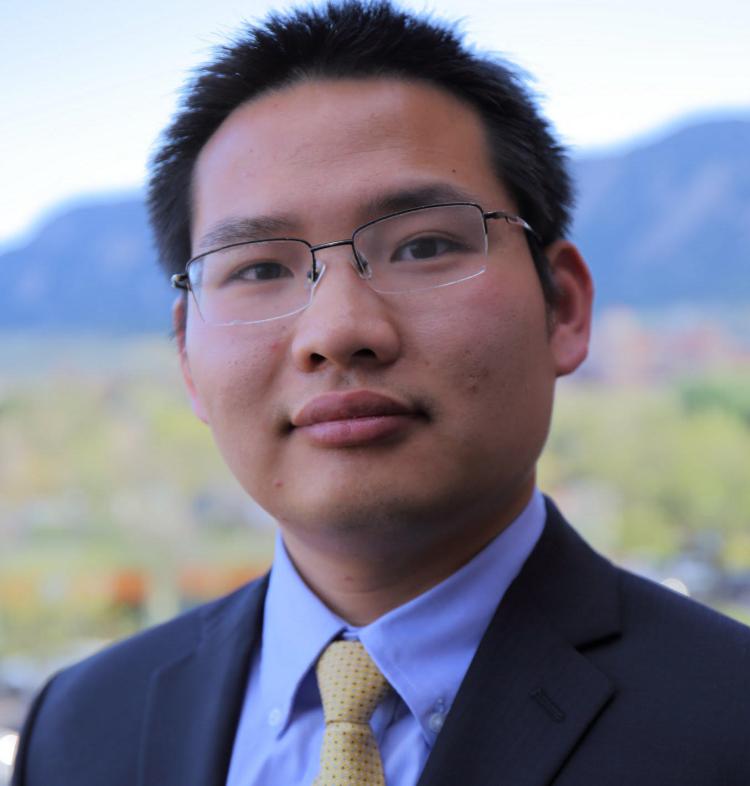Research shows how nanorobots may clean up contaminated soil, improve water filtration
Haichao Wu is the lead author on a new paper that describes a model system that can be used to help guide tiny self-propelled robots when exploring maze-like environments such as the spaces between grains of sand in soil.
Wu, a fifth-year PhD student in the Department of Chemical and Biological Engineering and part of the Schwartz Group, published the paper in Proceedings of the National Academy of Sciences of the United States of America. He said these “nanoswimmers” could one day be used to remediate contaminated soil, improve water filtration or even deliver drugs to targeted areas of the body.
We asked him about the work, where it is going from here and what it is like to study, learn and work with Professor Daniel Schwartz.
Question: How would you describe the work and results? What are the applications in the real world?
Answer: Scientists are developing synthetic nanoswimmers (also known as nanorobots or active particles) that can take energy from the environment and convert it into directional motion – also known as self-propulsion. These nanoswimmers exhibit some fascinating behaviors in groups, including swarming like a flock of birds, and scientists would like to use autonomous nanoswimmers to clean up contaminated soil, deliver drugs and many other applications that require the exploration of complex and interconnected maze-like environments. Many people remember the 1966 science fiction movie Fantastic Voyage, where a miniaturized submarine navigates the human body and helps to remove a blood clot. This scene has captured scientists’ attention for decades and demonstrates one possible use. Unfortunately, so far, nanoswimmers have not been successfully used for any practical purpose.
One major challenge is that if you put a nanoswimmer in a bucket of water, it is constantly tumbling, so its forward motion becomes scrambled, and it ends up moving randomly. In fact, it doesn’t cover much more territory than an ordinary passive “Brownian” particle that jiggles around due to random collisions with water molecules. Remarkably, we found that if you place a nanoswimmer into a porous environment, like the interconnected holes and pores inside a sponge, where the swimmer is surrounded by walls on all sides, then the situation is very different. In fact, nanoswimmers are able to make their way through these mazes as much as 25 times faster than randomly moving Brownian particles.
Ordinary Brownian particles have trouble moving through porous environments because they tend to get stuck inside tiny cavities, and it takes a long time for them to find the exit holes as they jiggle around randomly within a cavity. However, we found that nanoswimmers were incredibly effective at escaping cavities, since they moved along the cavity walls searching for holes, which allowed them to find the exits very quickly. Their self-propulsion also gave them a boost that allowed them to overcome the ubiquitous energy barriers at the exit holes, which basically act as gates that are difficult to pass through.
Q: Was there a particular aspect of this work that was hard to complete?
A: To quantitatively study the nanoswimmers’ transport behavior in porous media, I first needed to create a system where the porous structure was well-defined. I used a material called inverse opals, which consists of a regular interconnected network of spherical cavities, where each cavity has 12 circular holes connecting to adjacent cavities. A second challenge was the need to image nanoswimmer motion deep in the porous. There are significant light scattering effects at the boundaries of solid porous materials and void spaces, which prevents observation of fluorescent signals. To overcome this, I formulated a particular immersion liquid called a refractive-index matching liquid, which matched the optical properties of the porous material. This allowed me to obtain clear images of nanoswimmers inside porous materials. Finally, I found that 3D particle tracking was also necessary for this work because the 2D projection of nanoswimmer trajectories failed to capture many of the complex cavity translocation events.

Haichao Wu
Q: What research questions are still to be answered after this paper?
A: The mechanisms proposed here provide a strong rationale to employ nanoswimmers in complex and confined environments. But to accomplish complex tasks like environmental remediation or drug delivery an individual nanoswimmer is not enough. Those kinds of applications will require a large population of nanoswimmers. That brings up questions about cooperative swarming effects. How will nanoswimmers interact with each other in confined environments? How can we effectively employ a “nanoswimmer army” to solve difficult tasks? Can nanoswimmers and passive Brownian particles work synergistically?
Q: How have you liked living and studying in Boulder? What is it like to working with Professor Schwartz?
A: I have really enjoyed my graduate studies here at CU Boulder and it has provided a unique opportunity to have both world-leading research resources and world-class natural scenery. It is a great pleasure to work with Professor Schwartz – the best advisor you could ever ask for – because he is always extremely supportive and insightful!
“Mechanisms of Transport Enhancement for Self-Propelled Nanoswimmers in a Porous Matrix” was supported by the U.S. Department of Energy, Office of Science, Basic Energy Sciences, under Award No. DE-SC0001854. Other CU Boulder authors include PhD student Benjamin Greydanus, and Professor Daniel Schwartz from the Department of Chemical and Biological Engineering. Learn more.

